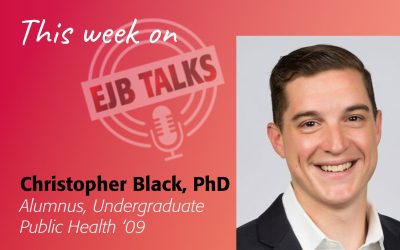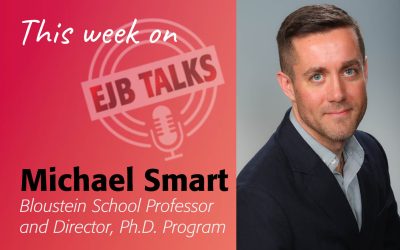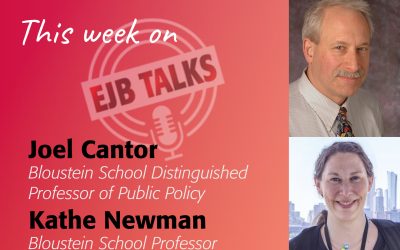Stuart Shapiro welcomes policy and planning alumnus Jorge Santos to EJB Talks this week to discuss Jorge’s experience at Bloustein and his post-graduation career path in economic development. Jorge talks about his new role at NJEDA, which he began just prior to the COVID shutdown, and how the NJEDA has helped small businesses during the economic crisis. He also discusses the new programs and initiatives created by the New Jersey Economic Recovery Act to help the state’s businesses, and how the NJEDA will work to quicken the pace and extent of economic improvement.
Stuart Shapiro
Welcome to EJBTalks. I’m Stuart Shapiro, the Associate Dean of Faculty at the Bloustein School. And the purpose of this podcast is to talk with my colleagues and our alumni about policy planning and health, the interactions between these issues, and how they affect people in New Jersey, the United States in the world.
Today, we have an alumnus of both of our master’s programs in public policy and in urban planning. And I think that for the first time on the podcast, a former student of mine. Jorge Santos currently works at the New Jersey Economic Development Authority. Welcome, Jorge.
Jorge Santos
Thanks for having me.
Stuart Shapiro
Absolutely. Can you tell us a little bit about your path from Bloustein to the NJEDA?
Jorge Santos
Sure. So before Bloustein, I was pretty involved in campaigns and government here in New Jersey, and I wanted to take more of a policy-type role in the future. And I really couldn’t decide if I wanted to concentrate more on general public policy, but I also had a passion for urban planning. Luckily enough, Bloustein offered a dual degree. So that’s what I did.
Shortly after I graduated, I started working for the Brick City Development Corporation in Newark, which then became the Newark Community Economic Development Corporation. I came on as a policy advisor and did a little bit of everything, working with developers, ushering projects through City Hall, helping on special city projects. Eventually, Aisha Glover became the president and CEO of the Newark EDC, and we worked on the Amazon bid proposal together. And it was a really great experience. Aisha moved on to the Newark Alliance and I followed her shortly after that. The Newark Alliance is a consortium of anchor institutions in the city, corporations like Prudential, but also nonprofits like NJPAC, for example. It is a really great organization.
And from there, I ended up being hired away, working for the Economic Development Authority. I started there in December of 2019. Ironically enough, Aisha also became a board member for the EDA, probably about a week or two after I joined. So she’s great. It’s great to continue working with her and the rest of our board.
Stuart Shapiro
Wonderful. So tell us a little bit about EDA. Probably some of our audience knows what they do, but others, particularly those out of state, are going to be utterly unfamiliar. So tell me about the agency you work for.
Jorge Santos
So the Economic Development Authority is an independent authority in, but not of, the Department of Treasury at the state, and we work with mostly small businesses. We offer low-interest loans and technical assistance. One of the larger avenues for bigger projects we do is economic development tax incentives, both corporate tax incentives and also real estate-based tax incentives. Recently, we had a new bill package, the Economic Recovery Act, which I think we’ll talk about in a little bit. And we’re busy standing up those programs.
But the EDA really helps to give businesses who are looking for that boost or looking for that assistance, that kind of help. And recently, under the Murphy Administration and Tim Sullivan our CEO, we’ve been trying to shape the EDA and kind of push it in an area where it’s a little bit more than a state financial institution, and really looks at the innovation economy and interesting project. So one of the big projects we’ve been pushing for, that we’re really excited about, is the wind port down in Salem County. And so that is going to be the state’s launching pad to become the premier center for offshore wind, up and down the East Coast.
And in addition to that, we’re working with the Department of Environmental Protection to do things for the Regional Greenhouse Gas Initiative that to helps push the electrification of vehicles. There are different environmental justice programs that have an economic component that comes out of EDA. And really looking at different sectors and how we can grow and promote innovation in those sectors, beyond just the traditional low-interest loans, which again, are important for a small business community, but not the only thing we want to do.
Stuart Shapiro
Right. So the bureaucracy nerd in me hears the first sentence you said there. You know, in but not of the Department of Treasury, and wondered what exactly does that mean?
Jorge Santos
So we have a governing board. The board is made up of several–I’m going to forget the exact numbers–several ex officio members from the state. So; the Department of Labor has a seat in our board, Banking and Insurance, Department of Treasury, Environmental Protection, and we also have several public members that the governor appoints. The senate president and speaker of the assembly also have some appointments to our board and they technically hire our CEO, usually on the recommendation of someone that the governor would recommend. In this instance, Tim Sullivan has been CEO since 2018. And so… we are a cabinet-level authority. And that’s a little bit unique for authorities. But we’re not a department. So that’s why Tim is the chief executive officer, he is not a commissioner, for the authority. And we have just a little bit more flexibility in some of the usual ways that the state operates.
Stuart Shapiro
Gotcha. So what has changed… this podcast started after the pandemic and has been looking a lot at the effects of the pandemic and the ensuing recession. Can you talk a little bit about if how, if at all, the pandemic has altered what EDA does?
Jorge Santos
Yes. So I started at EDA, like I said, in December of 2019. I was there for all of about three, three and a half months, just when I felt like I got my sea legs, and then we were all set to go work from home. So we’re coming up on almost a year of that. And the authority worked pretty well from home. To be honest, it’s worked out much better than we thought it would. I think that’s been the case for a lot of corporations and professional-type organizations.
In terms of priorities, we thought we were going to have a pretty full plate already with the wind port as I mentioned, and a few other initiatives we were looking at. And the governor was still working on getting an incentives package passed, which eventually we did at the end of 2020. But then the pandemic caused us to react and prepare and try to figure out how to help the small businesses that we knew were going to be shut down. So, before we even got sent home, we were preparing for a grant program off of the DEA balance sheet. We don’t get a state appropriation, as I mentioned, we’re a financing institution, and so we generate a lot of our own funds.
So we put up $5 million of our own money for a small grant program that was going to be focused on those industries that have direct face-to-face retail contacts. We were looking at restaurants, barber shops, personal care, those kinds of folks. And we launched that program, I think it was the first week of April. And we were way oversubscribed, as you can imagine. There was tremendous need, because these businesses were ordered to stop operating, and that was before any federal assistance came to the state. Once the federal assistance kit got here, the state was balancing using that money for public health needs as well as economic needs.
At the EDA, over the course of the year, we ended up with a phase one, phase two, and phase three grant program, as well as some loans of technical assistance. We’ve passed well over $200 million through the EDA into the hands of small businesses. And we’ve touched nearly 55,000 businesses at least through one of our smaller grants all the way up to loans in six figures. And normally, we just touch a few hundred businesses in a given year. So it’s been a real learning experience for the EDA and a real testament to the authority staff.
Again, I’ve just been there for a little over a year, and I’m continuously blown away just by how smart and dedicated, and innovative everyone that works at EDA is. So this grant program, for example, we learned… you’re working with federal regulations and making sure that you follow all the guidance from Treasury, which is evolving or vague, and they can come at you several years later to audit it. And, maybe you thought it was going to be one thing, and then it’s another thing. And so there’s a lot of stuff that goes on in the background, but we know the most important thing is just making sure these business owners get the assistance that they need right now.
Stuart Shapiro
Yeah, arguably, that’s never been more important than in the past year or so. So that brings us to the recent statute that passed, the Economic Recovery Act. What is that? And what does that mean for EDA?
Jorge Santos
The Economic Recovery Act is a big package…there’s one bill, but there are like several programs in there. And this is the successor to the Economic Opportunity Act of 2013. And in the Economic Recovery Act, there are several programs and changes to existing programs. So some of the new programs… there are seven new programs. There are successors to the GrowNJ and ERG programs. Those were the jobs-based and real estate based-tax incentive programs previously. So, that’s corporate attraction, corporate retention, subsidies to build housing or commercial buildings.
So, the new programs are Emerge and Aspire in the new bill and they’re similar, but we would argue, improved. Each program is now capped. So that helps, with an annual cap. We can budget and know exactly how much we’re going to be issuing every year. And this is an important tool for the state.
There are several new anti-corruption measures in there. There was… some may have read in the news, there was some attention given to how some of these programs were operated in the past, how certain folks were able to, let’s say, “game the system.” And so, we’ve tightened up those rules quite a bit. We’ve named the Chief Compliance Officer. There’s going to be an independent inspector general, appointed by the governor with the advice and consent of the Senate. CEOs must now certify to certain documentation under penalty of perjury, which was not the case before. So we’ve tightened up a lot of those things.
And then in addition to those two, I don’t want to call them premiere, but those two big programs that get all the attention, there are several other tax incentive programs that we’re really excited about. Some of them are community-based ones. We now have a Brownfields tax incentive to help clean up contaminated sites and buildings that may have asbestos or other contamination in them. And a Historic Property Reinvestment Act, geared towards, technically, I think the term is income-producing properties. So think of everything other than single-family homes. If you think of a place like downtown Newark, which has a lot of historic buildings where maybe those second, third, and fourth floors remain vacant because it’s not economically cost-effective to develop those spaces into office or residential space when the ground floor is bringing in enough rent. We hope that tax incentive helps to revitalize those areas.
We have a community anchor development program, and this is going to be pretty complex. But this is going to help us work with anchor institutions, like Rutgers University, like our performing arts centers, like museums or community colleges, and help them expand or develop new programs, or, new space in economically distressed areas. And there EDA will enter in as a partner. As opposed to just issuing a tax credit and kind of financing the project and taking a step back, we will be an active partner in those projects.
And the New Jersey Innovation Evergreen Fund is also an exciting program. Probably by the end of the year is our target. We will be auctioning off a bunch of tax credits, we’ll use those funds to partner with other businesses to go in 50/50 to help finance startup companies in the innovation economy. So it’s a really exciting way to leverage public dollars, as well as private expertise in growing those small to medium businesses that end up generating the most jobs.
And then the act involved several other tweaks to existing programs like the Angel Investor Tax Credit, and the Net Operating Loss Program, increasing the thresholds there. And, just getting back to small businesses. One of the exciting things about the program is there’s a $50 million appropriation for a Main Street Recovery Program. And we’re still–like all these programs–writing the rules and regulations, and that will be a lengthy process. But that will be additional direct assistance to small businesses, not necessarily COVID-impacted businesses, but to help grow our main streets in our small downtowns.
Stuart Shapiro
Great. I will say I think that’s the first time the phrase “tax incentives that we’re really excited about” has been used on the podcast there… (((laughing)))
Jorge Santos
(((Laughing))) Yeah .. just get tax and sales incentives…They’re just one other tool in the toolbox for everything else we’re doing at EDA, and they’re a good way to finance some really exciting programs.
Stuart Shapiro
So do you think, in terms of what EDA does that, a year from now, two years from now, it’ll be back to looking like it was pre-pandemic or has sort of the vision of what economic recovery is and economic development changed permanently?
Jorge Santos
That’s a hard question. It’s hard to predict the future. I think the pandemic has probably accelerated some existing trends. And this is really just kind of my personal opinion. And, we’re still, internally at the EDA and throughout government, where everyone is batting around ideas for what does this actually mean for the future? So, just speaking for myself, I don’t think the office building is dead. But I do think corporations are going to be forced, and probably even welcome, more flexible work from home policies.
Stuart Shapiro
Right.
Jorge Santos
So you might not need to be in the office five days a week, but you’re probably going to be in there three days a week, four days a week, work from home one day a week. If your kid is sick, if you have the sniffles but are still able to sit at a laptop, they’ll probably tell you to work from home instead of coming in and getting everyone else sick or taking a sick day.
And that will shape the way we see our downtowns as well as retail and online retail. We’ve seen an explosion of online shopping and ordering out. And one of the programs we implemented last year was technical assistance to try to help companies modernize a little bit; do online reservation systems, help them get some of their inventory online. Mixed success with that, there are different sophistication levels among small businesses, some folks that are used to doing things in a specific way. But, in some instances, it’s been really good, a really great success.
And I think those–again, this is probably the planner and me speaking– think place is still going to matter. And people are still going to want to congregate in interesting places. And those are going to continue to be our downtowns and our main streets. Just because you can go live in the middle of rural America and maybe work a full-time job in Manhattan. Some people are going to want to do that, but not everybody. Some people might have a suburban job and would much rather live in a dense urban area, and so they’re going to want to do that. So I think that really means that the attractiveness of your place to a workforce is going to matter even more. We already knew companies kind of followed workforces around the country. And they don’t necessarily need to do that as much. But if you’re a local government trying to grow your local tax base, you’re going to need to be more attractive, I think, to those workers.
Stuart Shapiro
Gotcha. Well, you mentioned your background in planning for our audience who include some of our students and maybe even potential students. I was wondering if you could conclude by talking for a moment about how your policy and planning degrees prepared you for where you are now?
Jorge Santos
Yeah, so at the EDA we do a lot of financing… public finance is really important. And how you view everything and your interactions with state and federal government are really important. But a lot of what we do is place-based. All of our tax incentive programs… I think all of our tax-centered programs have a geographic component to them. We’re looking at the distressed areas, areas that need more investment. Transit-oriented development is an important component of a lot of these programs. Reinvesting in walkable communities, green building, all of that plays a large role in our programs. And you need to be able to balance that with understanding the needs in other departments and the state understanding some of the politics behind it, behind, the state government and how it interacts with local government, and that all mishmashes together. And in a really interesting way, in a way that I really enjoyed.
Stuart Shapiro
Jorge, thanks for coming on. And it’s great to know that the three years you spent taking classes have paid off for you.
Jorge Santos
Thank you Stu. My time at Bloustein was really enjoyable. I love coming back to visit. I really do think it prepared me for my current career and I wouldn’t change it for anything.
Stuart Shapiro
Wonderful. Thank you also to Amy Cobb and Karyn Olsen for their usual outstanding production work. We’ll be back next week with another talk from another expert from the Bloustein School community. Until then, stay safe.




